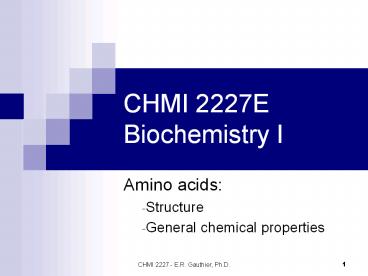CHMI 2227E Biochemistry I PowerPoint PPT Presentation
1 / 21
Title: CHMI 2227E Biochemistry I
1
CHMI 2227EBiochemistry I
- Amino acids
- Structure
- General chemical properties
2
Proteins Building blocks of life!
- Proteins are extremely complex molecules
- Proteins are involved in a vast variety of
biological structures and phenomena
- Silk
- Spider web
- Horns
- Antibiotics
- Toxins
- Enzymes
- Antibodies
- Hormones
- Membrane transporters
- Haemoglobin
- The building block for all proteins are amino
acids.
3
Amino acids
- An amino acid is a molecule in which a carbon
atom (Ca) is bonded simultaneously to a
carboxylic acid (COOH) and an amine group (NH2) - Hundreds of amino acids exist in nature
- However, only 20 amino acids are used by the cell
to make proteins.
- Each amino acid differs from all the others by
the nature of the R group. - Each R group differs from the others in several
ways - Size
- Charge
- Water solubility
4
General properties of amino acids.
- Note that the Ca is bonded to 4 different groups
and is chiral - Two stereoisomers are distinguished
- L-amino acids
- D-amino acids
- Only the L-amino acids are found in proteins.
- L amino group is on the left in the Fisher
representation. - L and D arbitrary. Has nothing to do with the
direction of rotation of polarised light by the
amino acid.
5
General properties of amino acids.
- Every amino acids has at least two chemical
groups that can be ionized - Carboxylic Acid (COOH)
- Amino (NH2)
6
Amino acid titration1. simplest scenario
- pI isoelectric point pH where 100 zwitterion
- pI pKa1 pKa2
- 2
- The fraction of COOH or NH2 group that is charged
at any given pH can be determined with the
Henderson-Hasselbach equation - pH pKa log A-
- HA
7
The twenty amino acids
8
Structure of the 20 amino acids1. Hydrophobic
amino acids
- All these amino acids are NOT soluble in water.
- Note glycine is NOT optically active. Why?
9
Structure of the 20 amino acids1. Hydrophobic
amino acids
- Proline is the only cyclic amino acid
10
Structure of the 20 amino acids2. Aromatic amino
acids
11
Structure of the 20 amino acids2. Aromatic amino
acids
- Tyr, Trp and Phe are very useful
- Their aromatic ring absorb UV light at 260-280
nm. - Form the basis of protein detection at 280 nm.
Absorbance Absorbance
?max (nm) Molar Absorbance (M-1 cm-1)
Phenylalanine 257.4 197
Tyrosine 274.6 1420
Tryptophan 279.8 5690
12
Structure of the 20 amino acids3. polar,
uncharged amino acids
13
Structure of the 20 amino acidsCysteine and
cystine
14
Structure of the 20 amino acids Tyr, Ser, Thr
15
Structure of the 20 amino acids4. Negatively
charged amino acids
16
Structure of the 20 amino acids4. Negatively
charged amino acids
17
Structure of the 20 amino acids5. Positively
charged amino acids
18
Structure of the 20 amino acids5. Positively
charged amino acids His
19
Structure of the 20 amino acidspKa values of
amino acids
20
Analysis of amino acids1. Ion exchange
chromatography
- Different types of ion exchange resins exist
- Cation exchange negatively charged/separation of
cations - Anion exchange positively changed/separation of
anions. - Obviously, the type of resin to be used will
depend on the charge of the amino acid on
interest, itself dependent on the pH of the
solution.
21
Analysis of amino acids2. Detection of amino
acids ninhydrin reagent
- While Trp, Phe and Tyr can be detected by their
A260-280nm, the other amino acids cannot - Ninhydrin reacts with the amine group of amino
acids, generating a purple product (yellow in the
case of Pro). - The ninhydrin reaction allows one to detect and
quantify (A570nm) the amino acids contained in
the fractions of the IEX column.

